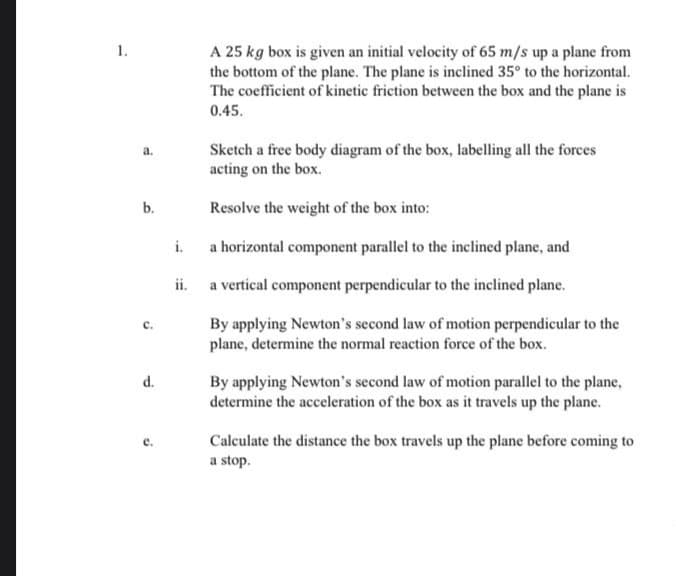A 25 kg box is given an initial velocity of 65 m/s up a plane from the bottom of the plane. The plane is inclined 35° to the horizontal. The coefficient of kinetic friction between the box and the plane is 1. 0.45. Sketch a free body diagram of the box, labelling all the forces acting on the box. b. Resolve the weight of the box into: i. a horizontal component parallel to the inclined plane, and ii. a vertical component perpendicular to the inclined plane.
A 25 kg box is given an initial velocity of 65 m/s up a plane from the bottom of the plane. The plane is inclined 35° to the horizontal. The coefficient of kinetic friction between the box and the plane is 1. 0.45. Sketch a free body diagram of the box, labelling all the forces acting on the box. b. Resolve the weight of the box into: i. a horizontal component parallel to the inclined plane, and ii. a vertical component perpendicular to the inclined plane.
University Physics Volume 1
18th Edition
ISBN:9781938168277
Author:William Moebs, Samuel J. Ling, Jeff Sanny
Publisher:William Moebs, Samuel J. Ling, Jeff Sanny
Chapter6: Applications Of Newton's Laws
Section: Chapter Questions
Problem 39P: A student’s backpack, full of textbooks, is hung from a spring scale attached to the ceiling of an...
Related questions
Question

Transcribed Image Text:A 25 kg box is given an initial velocity of 65 m/s up a plane from
the bottom of the plane. The plane is inclined 35° to the horizontal.
The coefficient of kinetic friction between the box and the plane is
1.
0.45.
Sketch a free body diagram of the box, labelling all the forces
acting on the box.
a.
b.
Resolve the weight of the box into:
i.
a horizontal component parallel to the inclined plane, and
ii. a vertical component perpendicular to the inclined plane.
By applying Newton's second law of motion perpendicular to the
plane, determine the normal reaction force of the box.
d.
By applying Newton's second law of motion parallel to the plane,
determine the acceleration of the box as it travels up the plane.
Calculate the distance the box travels up the plane before coming to
a stop.
Expert Solution
This question has been solved!
Explore an expertly crafted, step-by-step solution for a thorough understanding of key concepts.
Step by step
Solved in 3 steps with 2 images

Knowledge Booster
Learn more about
Need a deep-dive on the concept behind this application? Look no further. Learn more about this topic, physics and related others by exploring similar questions and additional content below.Recommended textbooks for you

University Physics Volume 1
Physics
ISBN:
9781938168277
Author:
William Moebs, Samuel J. Ling, Jeff Sanny
Publisher:
OpenStax - Rice University

University Physics Volume 1
Physics
ISBN:
9781938168277
Author:
William Moebs, Samuel J. Ling, Jeff Sanny
Publisher:
OpenStax - Rice University